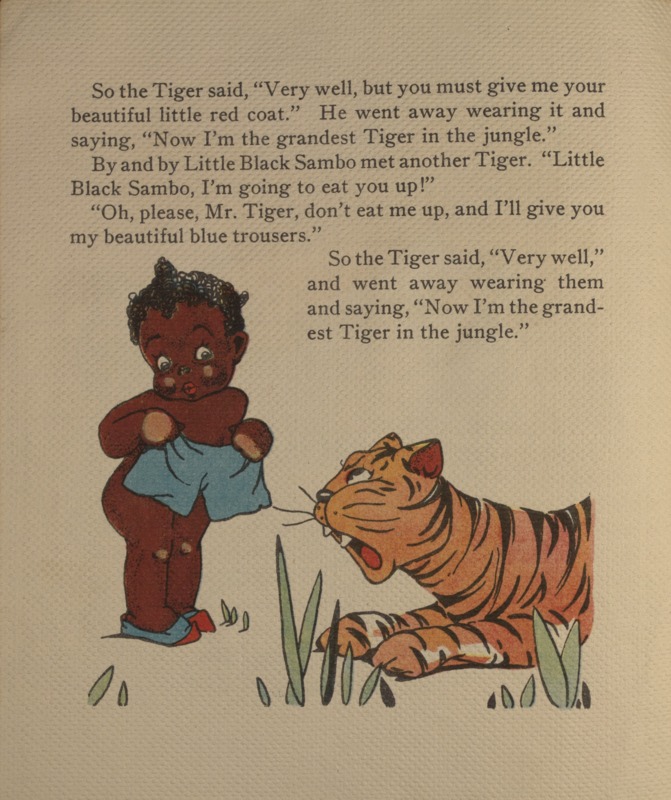This version of Sambo by Betty Bell Rea (1938) is among the youngest portrayals of Sambo. Unlike a usual picaninny caricature, he is not depicted as being overgrown or older for his age; in fact he looks no more than three or four years old. This representation also departs from other stereotypical picaninny characteristics such as a wide mouth and broad nose. The rosy cheeks and lips and wide eyes further add to the element of young innocence here. The cheeks and pouty lips, along with the nudity and other typically dainty and feminized mannerisms – such as standing with feet together, protruding buttocks, holding clothes up as if to protect his modesty – make this Sambo a very effeminate and eerily sexualized figure. This gender non-conforming and gender indeterminate Sambo plays into disturbing representations of black boys and men as effeminate to render them non-threatening.
The idea that Sambo could be sexualized is not unusual. Black children are often portrayed with “exposed genitalia and buttock – often without apparent shame. Moreover, the buttocks are often exaggerated in size, that is, black children are shown with the buttocks of adults. The widespread depictions of nudity among black children normalizes their sexual objectification, and, by extension, justifies the sexual abuse of these children” (Pilgrim 2000). However, this Sambo does not lack apparent shame. Another unusual aspect about this sexualized depiction is that Sambo is male (whereas it is usually females who are subjected to such objectification). Furthermore, he is young, which while disturbing is not altogether surprising. Historically, it has not been unusual for black girls to be sexualized from a very young age: “antebellum black children, like black women, were assumed to be ineligible for sexual purity…the sale of enslaved prepubescent girls calculated ‘their sexuality, or at the very least their anticipated fertility’ into their pricing” (Bernstein 42). Sexual innocence was therefore something denied to young black girls. However, black boys have stereotypically been portrayed as devoid of innocence in other ways; they are perpetual bad boys, always viewed as having criminal intentions.
It is an uncharacteristic situation, then, to see a young black boy being sexualized. It renders him non-threatening in different ways than an average Sambo stereotype does. The stereotypical Sambo has always been harmless and nonsexual, in comparison to other representations of black males, such as the Savage or the Brute, who is represented as more aggressive, rebellious against slave masters and hypersexualized. Furthermore, in parallel to the black female Mammy stereotype, who is often depicted as masculinized, Sambo is weak, dependent and effeminate (Nuruddin 291-338). A typical Sambo therefore serves as an antithesis to both the Savage and the Mammy, and in doing so, not only reduces the threat of the rebellious slave but also renders anxieties about black men’s imagined threat to with white women mute.
Here, Rea’s Sambo looks dainty, in need of protection, and desirous of protecting his modesty (as female stereotypes playing on benevolent sexism would). One could argue that this gender fluid Sambo helps us envision a new black masculinity where black boys and men can display “feminine” attributes such as nonaggressive behavior and sensitivity, like many white male characters often do, and in the process challenge essentialist macho notions of masculinity (Brooks and Hebert, 305). However, what makes this different is the fact that Rea’s Sambo is not just feminine but is also sexualized in a racialized way – all the while the tiger remains ready to pounce. Once again Sambo is not just a child to be consumed. Here his sexuality is also up for consumption, as black female sexualities have been historically consumed by the white gaze.
Bernstein, Robin. Racial innocence: Performing American childhood from slavery to civil rights. NYU Press, (2011).
Nuruddin, Yusuf. "The Sambo thesis revisited: Slavery's impact upon the African American personality." Socialism and Democracy 17.1 (2003): 291-338.
Brooks, Dwight E., and Lisa P. Hébert. "Gender, race, and media representation." Handbook of gender and communication 16 (2006): 297-317.
Rea, Betty-Bell. Little Black Sambo. Akron: Saalfield Pub, (1938). Print.
